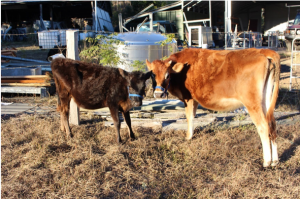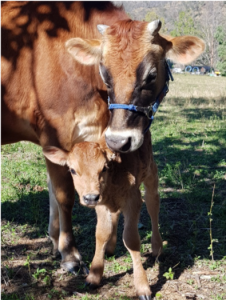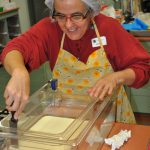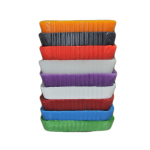It all started over 20 years ago after the birth of my second child that I got interested in quality food for my family. This incorporated attending the Northy Street Organic Markets (Brisbane) in search of good organic food and introduced me to Cleopatras Raw Organic Milk. It reminded me of how good milk used to taste and I tried to make some butter from their cream. It was a glorious golden yellow and tasted great but due to my inexperience I didn’t get rid of all the buttermilk so it started to smell a little strong over time so was a bit off-putting, as was the price. That experience sparked the dream to someday have my own copious amounts of quality milk – a house cow. After 10 years of searching in 2014 we found our patch in the country and in 2017 we sold everything in Brisbane and moved out to the Lockyer Valley.
In 2018 I did a cheesemaking course 1 run by Graham as we were planning for that house cow and wanted to learn how to make good cheese the whole family will enjoy. I had done a previous permaculture cheesemaking workshop years ago but I never actually made cheese after it. I had made feta from a book and failed a few times trying to make the mozzarella.
It wasn’t till August 2020 that we finally had our first calf and started milking our very first house cow. Getting a house cow can be a rather drawn-out process, especially if you can’t find one for sale. We got a 7month old jersey calf, Butterscotch, from another family who unfortunately couldn’t keep her anymore due to space. She had been very well looked after and loved people. We had to wait till she was 15 months old to mate her and then another nine months till her calf was born. So – a long time to wait for our own milk.
- The house cows “to be” Caramel and Butterscotch
- Butterscotch with her new one day old calf, Taffy
We do not hand milk her as it just didn’t work out. After she birthed her calf, we tried to milk her out but being both newbies, the cow AND us, she was unhappy and we were unconfident, so my husband did a mercy dash into Brendale (Brisbane) (4 hr round trip) to get a bucket milker. It is just like a mini dairyman’s milking system, with only one milking claw. Now previously, when we had discussed our plans with having a milking cow it was decided that I would be the milker – lots of milkmaid jokes abounded – till we found I couldn’t use the bucket milker! My hands just aren’t large enough, so now we milk together every morning with him being the milkman and my assistant. We milk for only about 2 minutes and the milk goes straight from the cow through tubing into the sealed bucket then into a sanitise (hot water) bucket and to the house to be decanted into bottles (washed in the dishwasher). As we still have the calf with Butterscotch we only have to milk once a day and separate them each evening. We generally get around 6-7 litres of milk every morning and as we have another dairy heifer ready to give birth from mid-November onwards, We will have double amounts of milk soon. I intend to get a cream separator and start making butter and ice cream. I have found that skimming the cream manually just isn’t practical for large amounts and I make a great tasty Greek yogurt with the leftover skimmed milk. Unlike tradition, we don’t feed our cow grain so it is important to feed her high-quality hay and good quality pasture – when it rains! Feeding grain would up her milk amount but we have more than enough for our needs anyway!
I have found that I can make Persian fetta with milk straight from the cow without having to heat it up, actually have to wait for it to cool a little. It works great, I haven’t had any issues but found that I seem to have less cream separation on setting in comparison to using already cooled milk. Cooling the milk seems to set it a bit. I then drain it and add onions and chives to make a great spreading cheese for homemade sourdough bread or crackers. I have had success with making Camembert, Brie, and Farmhouse Cheddar (FHC), with unrefrigerated raw milk straight from the cow. We have yet to try the cheddar as it is still maturing so probably shouldn’t call that a success till then. I have also made fresh mozzarella with raw milk.
At the moment I am using an old camping fridge/freezer to mature and store my cheeses, but am looking at adapting a bar fridge for storing the hard cheeses. The soft ones get wrapped, named and dated, and put in a closed plastic container in the normal fridge till eaten.
I have been making cheese almost every second day, trying different hoop sizes, and doubling recipes to get through the quantity of milk we have. I have become very familiar with the main three recipes I have been doing, Camembert, Brie, and FHC. I like to get good at doing the basics before moving on to anything fancy, but also think it is important to produce something we love to eat so it is not wasted. This whole process has imbued me with a respect for the value of the product I use and a desire to produce a good cheese that will be appreciated. So far everyone who has tried the soft cheeses has complimented me and Butterscotch for it, using such high-quality sweet milk helps to produce a high-quality cheese.
I was quite chuffed the other day when I made spinach and ricotta cannelloni, which the family really enjoyed, and the only bought ingredient was the cannelloni! It had whole milk ricotta, veggies, and tomato passata from our large possum-proofed garden and some fresh mozzarella to top it off.
Having our own milk cow is a great responsibility but a step on the way to sourcing high-quality ingredients to accompany my homemade sourdough bread, kefir, and kombucha. I also make jam and marmalade, broth, lard, and elderflower champagne. Unfortunately, after an emergency ambulance ride and many stitches, I learned the hard way to use plastic for storing effervescent drinks – not glass!
Great-tasting milk, cheese, yogurt, butter, and cream is a step towards the degree of self-sufficiency that we wanted to try for when we left the city and moved to the country 3 and a half years ago. It hasn’t been an easy journey but one I have yet to regret – and I’ll have all the camembert and brie I could want along the way!





